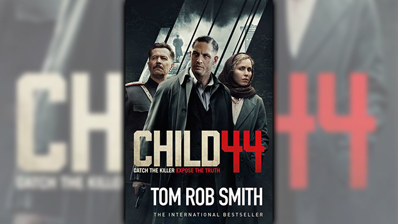Stephanie Jones: Book Review - Child 44 by Tom Rob Smith
- Publish date
- Friday, 10 Apr 2015, 11:39AM

Tom Rob Smith, raised in London by an English father and Swedish mother, made his name as a crime writer in 2008 with his debut novel, Child 44, in which he drew on the case of the real-life serial killer Andrei Chikatilo to craft a chilling tale of paranoia, subterfuge and state-sponsored terror within the suffocating fog of Stalinism. The novel was a bestseller and longlisted for the Man Booker Prize, and its re-release precedes the premiere of the film adaptation in the UK, Europe and North America this month.
On re-reading, Child 44 succeeds for the same reasons it did seven years ago. Smith’s sense of history is acute and astute, Soviet Russia being surely as bleak a place and time in which to be human as has ever existed. The narrative’s driving force, military hero Leo Demidov’s hunt for a serial killer of children and young women, is thrilling not just for its own sake but for the threat it poses to the Soviet worldview.
In the psychosocial methodology of the Russian state under the omnipotent Stalin, absolute control of the citizenry is maintained through many mechanisms, none too foul, cruel or counterproductive to avoid widespread application. A central tenet of Soviet absurdism is that there is no such thing as crime. The presumption of innocence doesn’t exist either, and the bringing of a case to court means that the accused cannot be anything but guilty – a case that is ambiguous or complex simply won’t be opened. A typically contradictory Stalin aphorism, “Trust but Check”, roughly translates to “Those who appear the most trustworthy deserve the most suspicion.”
In this nightmarish sociocultural landscape, Leo is among the lucky ones. Married to Raisa, his role in the Soviet liberation of German-occupied territory has earned him fast-rising status in the MGB, the State Security force, and corollary benefits for his elderly parents, who because of his position are afforded rare comforts such as their own apartment and access to the spetztorgi, special shops not open to the general public. In the aftermath of World War II and the midst of the Cold War, not to mention a recent crushing famine in Ukraine that drove the populace to cannibalism, Leo has every reason to protect the status quo.
Unfortunately for him, but happily for the reader, he has a moral code not typical of many of his peers or superiors, and when a colleague claims that his four-year-old son, found dead on local railway tracks, was murdered, Leo finds himself unable to follow protocol by looking away. As body after body, each bearing signposts leading to a common killer, turns up in his path, neither his demotion and exile nor the ghoulish promise of the Gulag will stop him hunting down a predator who cannot officially exist.
Smith’s storytelling is commendable for many reasons. He translates the results of his extensive researching to the page with great subtlety, the skill of embedding historical detail without hitting the reader over the head with it being surprisingly rare. His villains are ghastly, but not cartoonish. Their madness makes sense, albeit to depressing effect.
The story, with its multiple timeframes and geographical settings, is superbly constructed, and scenes of action and sadistic violence have a frank clarity. Child 44 is fiction injected with some of the worst of human history, set in the grimmest of times that were devoid of passion or hope. For any admirer of thought-provoking crime or historical fiction it cannot be more highly recommended.
Take your Radio, Podcasts and Music with you

